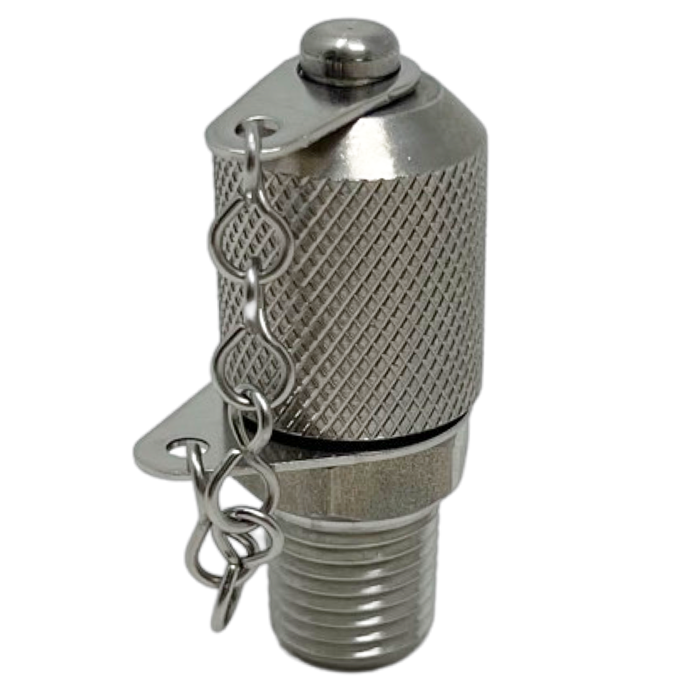(Some of you may have seen that while I'm SLOWLY going over and cleaning up my 20 year old (seemingly, almost-pristine) RIX SA-6AG and preparing to fire it up, I'm planning for the future. While I will probably create a specific unit/build thread, I have some more generic questions that are not "type", much less unit-specific, so I think deserving of their own threads ...)
One of the things I see frequently is that one of the best compressor diagnostic and monitoring tools it to check the pressures at the various compression stages. Big fixed units seem to frequently have these, but portable units general don't. I'm going to be re-plumbing mine to allow access. An option I am strongly considering is to allow either easily disconnectable and/or remote gauges, to minimize damage from long-term vibration and handling of a portable, open unit. That might also be tied in with a demountable fill panel (a topic for "someday").
In nosing around for various solutions, ranging from paintball QDs, to AN or JIC connectors, I stumbled across "M16x2" test-ports used for hydraulic systems that can be safely connected and disconnected under pressure.

They are fairly reasonably priced and available with 9000 psi rating, Viton seals, in zinc/nickel-plated carbon steel ($11- TPPM1620CVN1/4 : Anchor Test Point, 9000psi Rated, 1/4" NPT, Viton Seals, Zinc/Nickel Plated Carbon Steel) or in SS ($37- TPPM1620SVN1/4 : Anchor Test Point, 9000psi Rated, 1/4" NPT, Viton Seals, Stainless Steel) - Model Specs (https://onehydraulicsdata.s3.amazonaws.com/DATASHEETS/TestPointBrochure_May2020_Digital.pdf).
Rigid gauge-adapters (Test 20 x 1/4) and Microbore style hoses (M16x2 X NPT Test Hose) are available in multiple lengths with 1/4"-NPTF on the other end for direct gauge connection or adaptation to plumbing on a remote panel.
ETA:
Well I went down the rabbit hole and after an hour+ of searching I found that despite being a relatively well known plating option ON stainless steel, zinc-nickel, is evidently still highly galvanic with stainless. So I am guessing the answer to my 3rd question is "Probably should pay 3.5x for the stainless fixed points" if I am going to be screwing it into stainless NPT fittings.
One of the things I see frequently is that one of the best compressor diagnostic and monitoring tools it to check the pressures at the various compression stages. Big fixed units seem to frequently have these, but portable units general don't. I'm going to be re-plumbing mine to allow access. An option I am strongly considering is to allow either easily disconnectable and/or remote gauges, to minimize damage from long-term vibration and handling of a portable, open unit. That might also be tied in with a demountable fill panel (a topic for "someday").
In nosing around for various solutions, ranging from paintball QDs, to AN or JIC connectors, I stumbled across "M16x2" test-ports used for hydraulic systems that can be safely connected and disconnected under pressure.

They are fairly reasonably priced and available with 9000 psi rating, Viton seals, in zinc/nickel-plated carbon steel ($11- TPPM1620CVN1/4 : Anchor Test Point, 9000psi Rated, 1/4" NPT, Viton Seals, Zinc/Nickel Plated Carbon Steel) or in SS ($37- TPPM1620SVN1/4 : Anchor Test Point, 9000psi Rated, 1/4" NPT, Viton Seals, Stainless Steel) - Model Specs (https://onehydraulicsdata.s3.amazonaws.com/DATASHEETS/TestPointBrochure_May2020_Digital.pdf).
Rigid gauge-adapters (Test 20 x 1/4) and Microbore style hoses (M16x2 X NPT Test Hose) are available in multiple lengths with 1/4"-NPTF on the other end for direct gauge connection or adaptation to plumbing on a remote panel.
- What thoughts do y'all have on the concept?
- Concerns if I stick to < 40%?
- Can I reasonably get away with zinc/nickel-plated carbon steel or do I need to go with SS for the fixed test points since they contact the gas-flow path?
ETA:
Well I went down the rabbit hole and after an hour+ of searching I found that despite being a relatively well known plating option ON stainless steel, zinc-nickel, is evidently still highly galvanic with stainless. So I am guessing the answer to my 3rd question is "Probably should pay 3.5x for the stainless fixed points" if I am going to be screwing it into stainless NPT fittings.




